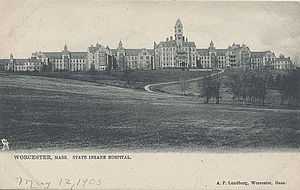Worcester State Hospital
| Worcester State Hospital | |
|---|---|
| Massachusetts Department of Mental Health | |
.jpg) Administration building | |
| Geography | |
| Location | Worcester, Massachusetts, United States |
| Organization | |
| Hospital type | Mental hospital |
| Services | |
| History | |
| Founded | 1876 |
| Closed | 1991 |
| Links | |
| Other links | |
|
Worcester Asylum and related buildings | |
 | |
| Location | 305 Belmont St., Worcester, Massachusetts |
| Coordinates | 42°16′43.2″N 71°46′9.5″W / 42.278667°N 71.769306°WCoordinates: 42°16′43.2″N 71°46′9.5″W / 42.278667°N 71.769306°W |
| Built | 1870-1876 |
| Architect | Weston & Rand; Et al. |
| Architectural style | Gothic |
| Governing body | State |
| MPS | Worcester MRA |
| NRHP Reference # | 80000530[1] |
| Added to NRHP | March 05, 1980 |
Worcester State Hospital was a Massachusetts state mental hospital located in Worcester, Massachusetts. It is credited to the architectural firm of Weston & Rand. The hospital and surrounding associated historic structures are listed as Worcester Asylum and related buildings on the National Register of Historic Places.[1]
It was once known as the Worcester Lunatic Asylum and the Bloomingdale Asylum. The hospital dates back to the 1830s. On January 12, 1833, the Worcester Insane Asylum opened. It was the first of its kind in the state. During the first year, 164 patients were received.
Soon overcrowded, superintendent Merrick Bemis called for the construction of a new asylum. A massive structure was to be laid out in the Kirkbride Plan and located on Belmont Street. Construction began in 1870 and the newly built Worcester State Hospital was completed in 1876 at the cost of well over a million dollars. The building seems to reflect more of a prison complex in the styles, layout, and sheer size of the institution.[2]
History
In 1901 a satellite facility which became the Grafton State Hospital was opened in nearby Grafton, Massachusetts to give non-violent patients an opportunity to engage in therapeutic work in a rural environment.

During its operation, the hospital housed thousands of patients. In 1949, the daily operations of the facility were documented by Life magazine.[2]
Current use and redevelopment
Although the facility was officially closed in 1991, operations still continue at the facility in a newer building. In 2004 a proposal to build a new facility on this property was put into the works and called for all of the remaining newer and old building to be torn down.
The patients in the newer building had no air conditioning and room temperatures sometimes exceeded 100 degrees Fahrenheit in the summer.
Erecting the new hospital will take the place of both the current Westborough and Worcester State hospitals.
In 2008, there were plans to film Shutter Island on the grounds of the hospital. Because of the pending demolition of the facility, filming was not approved and instead the filming took place at Medfield State Hospital.
In 2008, the remaining buildings on the property with the exception of the clock tower administration building and the Hooper Turret were torn down.[2] As of 2009 there have been plans made to secure and maintain the exterior of the main administration building and possible refurbishing of the clock tower itself. A fitness trail around the perimeter of the grounds has been drawn up and may be put in place in the near future.
As of 2012, plans are going ahead to demolish the historic administration building, and to replace it with a monument replicating the clock tower using some of the original construction materials.[3] Although local preservationists consider this preferable to complete demolition, many are disappointed by the state's lack of commitment to historic preservation.[4] As of August 2012, three concentric fences have been put up around the Clocktower building, and wrecking equipment is poised to tear down the tower.[5]
A new hospital has been built. The new facility, which will be named the Worcester Recovery Center and Hospital, is on the grounds of the old hospital.[6] The clock tower will remain at the center of the grounds, directly in front of the main entrance. The new hospital will have three recovery stages- House, Neighborhood, and Downtown, progressing as recovery increases.[6] The facility has 260 adult beds, 30 adolescent inpatient beds and 30 adolescent intensive residential treatment beds.[7]
Notable faculty
- Andras Angyal, Psychiatrist in the research unit from 1937 to 1945.
- David Shakow,[8] Psychologist in the research unit
- Saul Rosenzweig, PhD [8] Psychologist in the research unit
See also
References
- ↑ 1.0 1.1 "National Register Information System". National Register of Historic Places. National Park Service. 2008-04-15.
- ↑ 2.0 2.1 2.2 "Worcester State Hospital". Worcester, Massachusetts: opacity.us. Retrieved 10 January 2010.
- ↑ "Deal Struck for Worcester State Hospital Clock Tower". Worcester, Massachusetts: golocalworcester.com. Retrieved 10 August 2012.
- ↑ "Tepid response to Worcester State Hospital clock tower replica idea". Worcester, Massachusetts: telegram.com. Retrieved 10 August 2012.
- ↑ "Worcester State Hospital". Worcester, Massachusetts: kingstonlounge.blogspot.com. Retrieved 14 August 2012.
- ↑ 6.0 6.1 http://www.boston.com/news/local/massachusetts/articles/2012/08/16/architecture_and_therapy_merge_at_new_302_million_state_mental_hospital/
- ↑ http://www.wbjournal.com/apps/pbcs.dll/article?AID=/20120817/NEWS01/120819947/1002
- ↑ 8.0 8.1 American Journal of Orthopsychiatry Volume 7, Issue 1, pages 32–35, January 1937
External links
- Kirkbride Buildings
- Photoessay on the 1877 Kirkbride complex
- WorcesterMass
- http://www.opacity.us/site56_worcester_state_hospital.htm
- The Coalition to Stop Institutional Violence records, 1972-1989 (bulk 1976-1981) are located in the Northeastern University Libraries, Archives and Special Collections Department, Boston, MA.
- http://www.asylumprojects.org/index.php?title=Worcester_State_Hospital